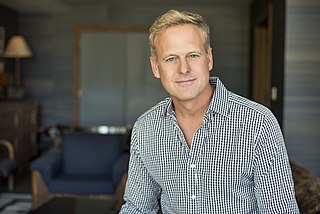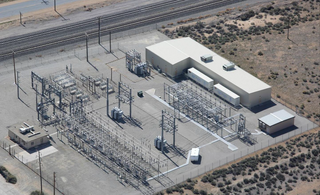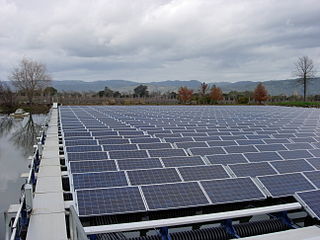Kiunga is a division in the Lamu District of Coast Province located close to the Indian Ocean coast of northern Kenya, and only 15 kilometres to the border with Somalia. A major marine conservation area, the Kiunga Marine National Reserve has its headquarters at Kiunga. The reserve is an important habitat for mangrove, turtles, and many species of birds. Total population of the division is 3310. In 2019, desalination plant powered by 50 kW solar panels was installed at Kiunga at a cost of 1⁄2 million US dollars by the non-profit organization GivePower, producing up to 70 tonnes of clean water per day.

Many countries and territories have installed significant solar power capacity into their electrical grids to supplement or provide an alternative to conventional energy sources. Solar power plants use one of two technologies:

Solar power is a fast-growing industry in Australia. As of September 2023, Australia's over 3.60 million solar PV installations had a combined capacity of 32.9 GW photovoltaic (PV) solar power, of which at least 3,823 MW were installed in the preceding 12 months. In 2019, 59 solar PV projects with a combined capacity of 2,881 MW were either under construction, constructed or due to start construction having reached financial closure. Solar accounted for 12.4% of Australia's total electrical energy production in 2021.

India's solar power installed capacity was 72.31 GWAC as of 30 November 2023.
For solar power, South Asia has the ideal combination of both high solar insolation and a high density of potential customers.

Solar power, also known as solar electricity, is the conversion of energy from sunlight into electricity, either directly using photovoltaics (PV) or indirectly using concentrated solar power. Photovoltaic cells convert light into an electric current using the photovoltaic effect. Concentrated solar power systems use lenses or mirrors and solar tracking systems to focus a large area of sunlight to a hot spot, often to drive a steam turbine.

Solar power includes solar farms as well as local distributed generation, mostly on rooftops and increasingly from community solar arrays. In 2022, utility-scale solar power generated 145.6 terawatt-hours (TWh), or 3.4% of electricity in the United States. Total solar generation that year, including estimated small-scale photovoltaic generation, was 204 TWh.
A photovoltaic system, also called a PV system or solar power system, is an electric power system designed to supply usable solar power by means of photovoltaics. It consists of an arrangement of several components, including solar panels to absorb and convert sunlight into electricity, a solar inverter to convert the output from direct to alternating current, as well as mounting, cabling, and other electrical accessories to set up a working system. It may also use a solar tracking system to improve the system's overall performance and include an integrated battery.

SolarCity Corporation was a publicly traded company headquartered in Fremont, California that sold and installed solar energy generation systems as well as other related products and services to residential, commercial, and industrial customers. The company was founded on July 4, 2006, by Peter and Lyndon Rive, the cousins of SpaceX and Tesla CEO Elon Musk. Tesla acquired SolarCity in 2016, at a cost of approximately US$2.6 billion and reorganized its solar business into Tesla Energy.

Solar power has been growing rapidly in the U.S. state of California because of high insolation, community support, declining solar costs, and a renewable portfolio standard which requires that 60% of California's electricity come from renewable resources by 2030, with 100% by 2045. Much of this is expected to come from solar power via photovoltaic facilities or concentrated solar power facilities.

Australia is the driest habitable continent on Earth and its installed desalination capacity has been increasing. Until a few decades ago, Australia met its demands for water by drawing freshwater from dams and water catchments. As a result of the water supply crisis during the severe 1997–2009 drought, state governments began building desalination plants that purify seawater using reverse osmosis technology. Approximately one percent of the world's drinkable water originates from desalination plants.

A rooftop solar power system, or rooftop PV system, is a photovoltaic (PV) system that has its electricity-generating solar panels mounted on the rooftop of a residential or commercial building or structure. The various components of such a system include photovoltaic modules, mounting systems, cables, solar inverters and other electrical accessories.

Hayes Barnard is an American entrepreneur. He is currently the founder, chairman, and CEO of GoodLeap, a technology-based finance company. Barnard is also the founder, chairman, and CEO of GivePower, a nonprofit that facilitates solar powered projects to provide clean water and energy systems to underserved communities.

A photovoltaic power station, also known as a solar park, solar farm, or solar power plant, is a large-scale grid-connected photovoltaic power system designed for the supply of merchant power. They are different from most building-mounted and other decentralized solar power because they supply power at the utility level, rather than to a local user or users. Utility-scale solar is sometimes used to describe this type of project.
Solar power in North Dakota has been a little-used resource. The state ranks last on installed solar power in the United States, with .47 MW of installed capacity. Solar on rooftops can provide 24.6% of all electricity used in North Dakota from 3,300 MW of solar panels. The most cost effective application for solar panels is for pumping water at remote wells where solar panels can be installed for $800 vs. running power lines for $15,000/mile.

The Australian electricity sector has been historically dominated by coal-fired power stations, but renewables are forming a rapidly growing fraction of supply.

The Tesla Powerwall is a rechargeable lithium-ion battery stationary home energy storage product manufactured by Tesla Energy. The Powerwall stores electricity for solar self-consumption, time of use load shifting, and backup power. The Powerwall was introduced in 2015 with limited production. Mass production started in early 2017 at Tesla's Giga Nevada factory. As of May 2021, Tesla has installed 200,000 Powerwalls.

Tesla Energy Operations, Inc. is the clean energy division of Tesla, Inc. that develops, manufactures, sells and installs photovoltaic solar energy generation systems, battery energy storage products and other related products and services to residential, commercial and industrial customers.

A battery storage power station is a type of energy storage power station that uses a group of batteries to store electrical energy. Battery storage is the fastest responding dispatchable source of power on electric grids, and it is used to stabilise those grids, as battery storage can transition from standby to full power in under a second to deal with grid contingencies.

Floating solar or floating photovoltaics (FPV), sometimes called floatovoltaics, are solar panels mounted on a structure that floats on a body of water, typically a reservoir or a lake such as drinking water reservoirs, quarry lakes, irrigation canals or remediation and tailing ponds. A growing number of such systems exist in China, France, Indonesia, India, Japan, South Korea, the United Kingdom, Singapore, and the United States.















